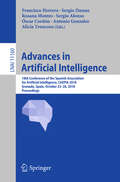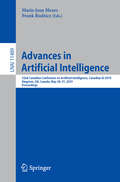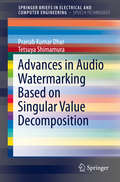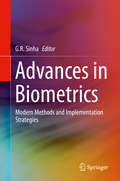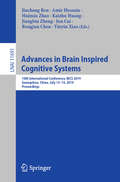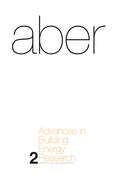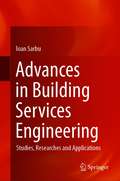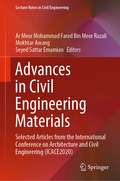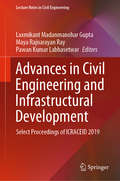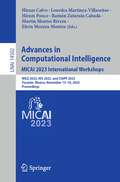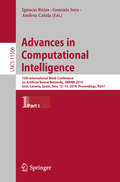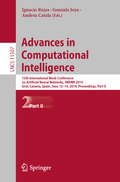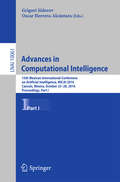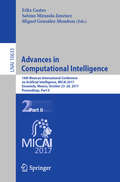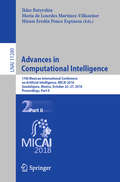- Table View
- List View
Advances in Artificial Intelligence – IBERAMIA 2022: 17th Ibero-American Conference on AI, Cartagena de Indias, Colombia, November 23–25, 2022, Proceedings (Lecture Notes in Computer Science #13788)
by Ana Cristina Bicharra Garcia Mariza Ferro Julio Cesar Rodríguez RibónThis book constitutes the refereed proceedings of the 17th Ibero-American Conference on Artificial Intelligence, IBERAMIA 2022, held in Cartagena de Indias, Colombia, in November 2022. The 33 full and 4 short papers presented were carefully reviewed and selected from 67 submissions. The papers are organized in the following topical sections: applications of AI; ethics and smart city; green and sustainable AI; machine learning; natural language processing; robotics and computer vision; simulation and forecasting.
Advances in Artificial Intelligence: 18th Conference of the Spanish Association for Artificial Intelligence, CAEPIA 2018, Granada, Spain, October 23–26, 2018, Proceedings (Lecture Notes in Computer Science #11160)
by Francisco Herrera Alicia Troncoso Sergio Damas Rosana Montes Sergio Alonso Óscar Cordón Antonio GonzálezThis book constitutes the refereed proceedings of the 18th Conference of the Spanish Association for Artificial Intelligence, CAEPIA 2018, held in Granada, Spain, in October 2018.The 36 full papers presented were carefully selected from 240 submissions. The Conference of the Spanish Association of Artificial Intelligence (CAEPIA) is a biennial forum open to researchers from all over the world to present and discuss their latest scientific and technological advances in Antificial Intelligence (AI). Authors are kindly requested to submit unpublished original papers describing relevant research on AI issues from all points of view: formal, methodological, technical or applied.
Advances in Artificial Intelligence: 19th Conference of the Spanish Association for Artificial Intelligence, CAEPIA 2020/2021, Málaga, Spain, September 22–24, 2021, Proceedings (Lecture Notes in Computer Science #12882)
by Enrique Alba Francisco Chicano Gabriel Luque Alicia Troncoso Manuel Ojeda-Aciego David Camacho Carlos Cotta Susana Montes José Riquelme Rodrigo Gil-MerinoThis book constitutes the refereed proceedings of the 19th Conference of the Spanish Association for Artificial Intelligence, CAEPIA 2020, which was cancelled due to the COVID-19 pandemic, amalgamated with CAEPIA 2021, and held in Malaga, Spain, during September 2021.The 25 full papers presented were carefully selected from 40 submissions. The Conference of the Spanish Association of Artificial Intelligence (CAEPIA) is a biennial forum open to researchers from all over the world to present and discuss their latest scientific and technological advances in Antificial Intelligence (AI). The book is subdivided into the following topical headings: machine learning, optimization and search, and real-world applications. It covers such themes as ambient intelligence and smart environments; computer vision and robotics; constraints, search and planning; creativity and A.I.; education and A.I.; explainable and responsible A.I.; foundation, models and applications of A.I, and others.
Advances in Artificial Intelligence: 32nd Canadian Conference on Artificial Intelligence, Canadian AI 2019, Kingston, ON, Canada, May 28–31, 2019, Proceedings (Lecture Notes in Computer Science #11489)
by Marie-Jean Meurs Frank RudziczThis book constitutes the refereed proceedings of the 32nd Canadian Conference on Artificial Intelligence, Canadian AI 2019, held in Kingston, ON, Canada, in May 2019.The 27 regular papers and 34 short papers presented together with 8 Graduate Student Symposium papers and 4 Industry Track papers were carefully reviewed and selected from 132 submissions. The focus of the conference was on artificial intelligence research and advanced information and communications technology.
Advances in Audio Watermarking Based on Singular Value Decomposition (SpringerBriefs in Speech Technology)
by Pranab Kumar Dhar Tetsuya ShimamuraThis book introduces audio watermarking methods for copyright protection, which has drawn extensive attention for securing digital data from unauthorized copying. The book is divided into two parts. First, an audio watermarking method in discrete wavelet transform (DWT) and discrete cosine transform (DCT) domains using singular value decomposition (SVD) and quantization is introduced. This method is robust against various attacks and provides good imperceptible watermarked sounds. Then, an audio watermarking method in fast Fourier transform (FFT) domain using SVD and Cartesian-polar transformation (CPT) is presented. This method has high imperceptibility and high data payload and it provides good robustness against various attacks. These techniques allow media owners to protect copyright and to show authenticity and ownership of their material in a variety of applications. · Features new methods of audio watermarking for copyright protection and ownership protection · Outlines techniques that provide superior performance in terms of imperceptibility, robustness, and data payload · Includes applications such as data authentication, data indexing, broadcast monitoring, fingerprinting, etc.
Advances in Biometrics: Modern Methods and Implementation Strategies
by G. R. SinhaThis book provides a framework for robust and novel biometric techniques, along with implementation and design strategies. The theory, principles, pragmatic and modern methods, and future directions of biometrics are presented, along with in-depth coverage of biometric applications in driverless cars, automated and AI-based systems, IoT, and wearable devices. Additional coverage includes computer vision and pattern recognition, cybersecurity, cognitive computing, soft biometrics, and the social impact of biometric technology. The book will be a valuable reference for researchers, faculty, and practicing professionals working in biometrics and related fields, such as image processing, computer vision, and artificial intelligence.Highlights robust and novel biometrics techniquesProvides implementation strategies and future research directions in the field of biometricsIncludes case studies and emerging applications
Advances in Brain Inspired Cognitive Systems: 10th International Conference, BICS 2019, Guangzhou, China, July 13–14, 2019, Proceedings (Lecture Notes in Computer Science #11691)
by Amir Hussain Jun Cai Huimin Zhao Jinchang Ren Jiangbin Zheng Kaizhu Huang Rongjun Chen Yinyin XiaoThis book constitutes the refereed proceedings of the 10th International Conference on Advances in Brain Inspired Cognitive Systems, BICS 2019, held in Guangzhou, China, in July 2019. The 57 papers presented in this volume were carefully reviewed and selected from 129 submissions. The papers are organized in topical sections named: neural computation; biologically inspired systems; image recognition: detection, tracking and classification; and data analysis and natural language processing.
Advances in Building Energy Research: Volume 2
by Mat Santamouris'Several high quality scientific journals are published in the area of building energy and indoor/outdoor environment; however, one has been missing. Advances in Building Energy Research fills the gap. I recommend ABER to all technical libraries, research institutes and universities. It should also be used by construction companies and those manufacturing building materials and building products.' Professor Olli Sepp nen, President of REHVA (Federation of Heating and Air-conditioning Associations) 'Advances in Building Energy Research is a unique index. It will be an inexhaustible resource for energy related sciences and a continuous inspiration for architects around the world.' N. Fintikakis, Architect and Director of UIA-ARES WP (Architecture and Renewable Energy Sources) Advances in Building Energy Research (ABER) offers state-of-the-art information on the environmental science and performance of buildings, linking new technologies and methodologies with the latest research on systems, simulations and standards. As stringently reviewed as a journal but with the breadth of a book, this annual volume brings together invited contributions from the foremost international experts on energy efficiency and environmental quality of buildings. Spanning a broad range of technical subjects, this is a 'must have' reference on global developments in the field, suitable for architects and building engineers, environmental engineers, industry professionals, students, teachers and researchers in building science, technical libraries and laboratories.
Advances in Building Services Engineering: Studies, Researches and Applications
by Ioan SarbuThis book provides a comprehensive, systematic overview of original theoretical, experimental, and numerical studies in the building services engineering domain. It brings together different strands of the topic, guided by the two key features of energy savings and reduction of the pollutant emissions. Technical, economic, and energy efficiency aspects related to the design, modelling, optimisation, and operation of diverse building services systems are explored. This book includes various theoretical studies, numerical and optimisation models, experiments, and applications in this field, giving an emphasis to: indoor environment quality assurance; energy analysis, modelling, and optimisation of heating systems; improving the energy performance of refrigeration and air-conditioning systems; valorising the solar and geothermal energies; analysis of thermal energy storage technologies; hydraulic simulation and optimisation of water distribution systems; and improving the energy efficiency of water pumping. With 11 pedagogically structured chapters, containing numerous illustrations, tables, and examples, this book provides researchers, lecturers, engineers, and graduate students with a thorough guide to building service engineering.
Advances in Civil Engineering Materials: Selected Articles from the International Conference on Architecture and Civil Engineering (ICACE2020) (Lecture Notes in Civil Engineering #139)
by Mokhtar Awang Seyed Sattar Emamian Ar Meor Mohammad Fared Bin Meor RazaliThis book presents selected articles from the 4th International Conference on Architecture and Civil Engineering 2020, held in Kuala Lumpur, Malaysia. Written by leading researchers and industry professionals, the papers highlight recent advances and address the current issues in the fields of civil engineering and architecture.
Advances in Civil Engineering and Infrastructural Development: Select Proceedings of ICRACEID 2019 (Lecture Notes in Civil Engineering #87)
by Pawan Kumar Labhasetwar Laxmikant Madanmanohar Gupta Maya Rajnarayan RayThis book comprises selected proceedings of the International Conference on Recent Advancements in Civil Engineering and Infrastructural Developments (ICRACEID 2019). The contents are broadly divided into five areas (i) smart transportation with urban planning, (ii) clean energy and environment, (iii) water distribution and waste management, (iv) smart materials and structures, and (v) disaster management. The book aims to provide solutions to global challenges using innovative and emerging technologies covering various fields of civil engineering. The major topics covered include urban planning, transportation, water distribution, waste management, disaster management, environmental pollution and control, environmental impact assessment, application of GIS and remote sensing, and structural analysis and design. Given the range of topics discussed, the book will be beneficial for students, researchers as well industry professionals.
Advances in Clean Energy Technologies: Select Proceedings of ICET 2020 (Springer Proceedings in Energy)
by Chetan Singh Solanki Prashant V. Baredar Srinivas TangellapalliThis book presents select proceedings of the international conference on Innovations in Clean Energy Technologies (ICET 2020) and examines a range of durable, energy efficient and next-generation smart green technologies for sustainable future by reflecting on the trends, advances and development taking place all across the globe. The topics covered include smart technologies based product, energy efficient systems, solar and wind energy, carbon sequestration, green transportation, green buildings, energy material, biomass energy, smart cites, hydro power, bio-energy and fuel cell. The book also discusses various performance attributes of these clean energy technologies and their workability and carbon footprint. The book will be a valuable reference for beginners, researchers and professionals interested in clean energy technologies.
Advances in Clean Energy Technologies: Select Proceedings of ICET 2023, Volume 1 (Springer Proceedings in Energy)
by Puneet Verma Gaurav Dwivedi Vikas ShendeThis book presents select peer-reviewed proceedings of the International Conference on Innovations in Clean Energy Technologies (ICET 2023) and examines a range of durable, energy-efficient, and next-generation smart green technologies for a sustainable future by reflecting on the trends, advances, and developments taking place across the globe. The topics covered include smart technologies-based products, energy-efficient systems, solar and wind energy, carbon sequestration, green transportation, green buildings, energy material, biomass energy, smart cities, hydropower, bio-energy, and fuel cells. The book also discusses various performance attributes of these clean energy technologies and their workability and carbon footprint. The book is a valuable reference for beginners, researchers, and professionals interested in clean energy technologies.
Advances in Clean Energy Technologies: Select Proceedings of ICET 2023, Volume 2 (Springer Proceedings in Energy)
by Puneet Verma Gaurav Dwivedi Vikas ShendeThis book contains select peer-reviewed proceedings from the International Conference on Innovations in Clean Energy Technologies (ICET 2023). It explores a variety of durable, energy-efficient, and next-generation smart green technologies aimed at promoting a sustainable future. The topics covered include smart technology-based products, energy-efficient systems, solar and wind energy, carbon sequestration, green transportation, green buildings, energy materials, biomass energy, smart cities, hydropower, bio-energy, and fuel cells. The book also discusses the performance attributes of these clean energy technologies, as well as their workability and carbon footprint. It is a valuable reference for beginners, researchers, and professionals interested in clean energy technologies.
Advances in Computational Collective Intelligence: 14th International Conference, ICCCI 2022, Hammamet, Tunisia, September 28–30, 2022, Proceedings (Communications in Computer and Information Science #1653)
by Djamal Benslimane Bogumiła Hnatkowska Jan Treur Costin Bădică Marek KrótkiewiczThis book constitutes refereed proceedings of the 14th International Conference on International Conference on Computational Collective Intelligence, ICCCI 2022, held in Hammamet, Tunisia, in September 2022. The 43 full papers and 15 short papers were thoroughly reviewed and selected from 421 submissions. The papers are grouped in topical sections on collective intelligence and collective decision-making; natural language processing; deep learning; computational intelligence for multimedia understanding; computational intelligence in medical applications; applications for industry 4.0; experience enhanced intelligence to IoT and sensors; cooperative strategies for decision making and optimization; machine learning methods.
Advances in Computational Collective Intelligence: 15th International Conference, ICCCI 2023, Budapest, Hungary, September 27–29, 2023, Proceedings (Communications in Computer and Information Science #1864)
by Ngoc Thanh Nguyen Gottfried Vossen Jan Treur Adrianna Kozierkiewicz Manuel Nunez László Gulyás János BotzheimThis book constitutes the refereed proceedings of the 15th International Conference on Advances in Computational Collective Intelligence, ICCCI 2023, held in Budapest, Hungary, during September 27–29, 2023.The 59 full papers included in this book were carefully reviewed and selected from 218 submissions. They were organized in topical sections as follows: Collective Intelligence and Collective Decision-Making, Deep Learning Techniques, Natural Language Processing, Data Minning and Machine learning, Social Networks and Speek Communication, Cybersecurity and Internet of Things, Cooperative Strategies for Decision Making and Optimization, Digital Content Understanding and Apllication for Industry 4.0 and Computational Intelligence in Medical Applications.
Advances in Computational Intelligence, Security and Internet of Things: Second International Conference, ICCISIoT 2019, Agartala, India, December 13–14, 2019, Proceedings (Communications in Computer and Information Science #1192)
by Ashim Saha Nirmalya Kar Suman DebThis volume constitutes the refereed proceedings of the Second International Conference on Computational Intelligence, Security and Internet of Things, ICCISIoT 2019, held in Agartala, India, in December 2019.The 31 full papers and 6 short papers were carefully reviewed and selected from 153 submissions. The papers are organised according to the following topics: Computational Intelligence, Security, Internet of Things. Papers from the extended track are also presented in the volume.
Advances in Computational Intelligence. MICAI 2023 International Workshops: WILE 2023, HIS 2023, and CIAPP 2023, Yucatán, Mexico, November 13–18, 2023, Proceedings (Lecture Notes in Computer Science #14502)
by Hiram Calvo Lourdes Martínez-Villaseñor Hiram Ponce Efrén Mezura-Montes Ramón Zatarain Cabada Martín Montes RiveraThis conference LNAI 14502 volume constitutes the workshop proceedings of 22nd Mexican International Conference on Artificial Intelligence, held in November 2023 in Mérida, Yucatán, México. The total of 34 papers presented in this volume was carefully reviewed and selected from 54 submissions.The proceedings of MICAI 2023 workshops are structured into three sections: – WILE 2023: 16th Workshop on Intelligent Learning Environments – HIS 2023: 16th Workshop of Hybrid Intelligent Systems – CIAPP 2023: 5th Workshop on New Trends in Computational Intelligence and Applications
Advances in Computational Intelligence: 15th International Work-Conference on Artificial Neural Networks, IWANN 2019, Gran Canaria, Spain, June 12-14, 2019, Proceedings, Part I (Lecture Notes in Computer Science #11506)
by Ignacio Rojas Gonzalo Joya Andreu CatalaThis two-volume set LNCS 10305 and LNCS 10306 constitutes the refereed proceedings of the 15th International Work-Conference on Artificial Neural Networks, IWANN 2019, held at Gran Canaria, Spain, in June 2019.The 150 revised full papers presented in this two-volume set were carefully reviewed and selected from 210 submissions. The papers are organized in topical sections on machine learning in weather observation and forecasting; computational intelligence methods for time series; human activity recognition; new and future tendencies in brain-computer interface systems; random-weights neural networks; pattern recognition; deep learning and natural language processing; software testing and intelligent systems; data-driven intelligent transportation systems; deep learning models in healthcare and biomedicine; deep learning beyond convolution; artificial neural network for biomedical image processing; machine learning in vision and robotics; system identification, process control, and manufacturing; image and signal processing; soft computing; mathematics for neural networks; internet modeling, communication and networking; expert systems; evolutionary and genetic algorithms; advances in computational intelligence; computational biology and bioinformatics.
Advances in Computational Intelligence: 15th International Work-Conference on Artificial Neural Networks, IWANN 2019, Gran Canaria, Spain, June 12-14, 2019, Proceedings, Part II (Lecture Notes in Computer Science #11507)
by Ignacio Rojas Gonzalo Joya Andreu CatalaThis two-volume set LNCS 10305 and LNCS 10306 constitutes the refereed proceedings of the 15th International Work-Conference on Artificial Neural Networks, IWANN 2019, held at Gran Canaria, Spain, in June 2019.The 150 revised full papers presented in this two-volume set were carefully reviewed and selected from 210 submissions. The papers are organized in topical sections on machine learning in weather observation and forecasting; computational intelligence methods for time series; human activity recognition; new and future tendencies in brain-computer interface systems; random-weights neural networks; pattern recognition; deep learning and natural language processing; software testing and intelligent systems; data-driven intelligent transportation systems; deep learning models in healthcare and biomedicine; deep learning beyond convolution; artificial neural network for biomedical image processing; machine learning in vision and robotics; system identification, process control, and manufacturing; image and signal processing; soft computing; mathematics for neural networks; internet modeling, communication and networking; expert systems; evolutionary and genetic algorithms; advances in computational intelligence; computational biology and bioinformatics.
Advances in Computational Intelligence: 15th Mexican International Conference on Artificial Intelligence, MICAI 2016, Cancún, Mexico, October 23–28, 2016, Proceedings, Part I (Lecture Notes in Computer Science #10061)
by Grigori Sidorov Oscar Herrera-AlcántaraThe two-volume set LNAI 10061 and 10062 constitutes the proceedings of the 15th Mexican International Conference on Artificial Intelligence, MICAI 2016, held in Canc#65533;n, Mexico, in October 2016. The total of 86 papers presented in these two volumes was carefully reviewed and selected from 238 submissions. The contributions were organized in the following topical sections: Part I: natural language processing; social networks and opinion mining; fuzzy logic; time series analysis and forecasting; planning and scheduling; image processing and computer vision; robotics. Part II: general; reasoning and multi-agent systems; neural networks and deep learning; evolutionary algorithms; machine learning; classification and clustering; optimization; data mining; graph-based algorithms; and intelligent learning environments.
Advances in Computational Intelligence: 16th International Work-Conference on Artificial Neural Networks, IWANN 2021, Virtual Event, June 16–18, 2021, Proceedings, Part II (Lecture Notes in Computer Science #12862)
by Ignacio Rojas Gonzalo Joya Andreu CatalaThis two-volume set LNCS 12861 and LNCS 12862 constitutes the refereed proceedings of the 16th International Work-Conference on Artificial Neural Networks, IWANN 2021, held virtually, in June 2021.The 85 full papers presented in this two-volume set were carefully reviewed and selected from 134 submissions. The papers are organized in topical sections on Deep Learning for Biomedicine, Intelligent Computing Solutions for SARS-CoV-2 Covid-19, Advanced Topics in Computational Intelligence, Biosignals Processing, Neuro-Engineering and much more.
Advances in Computational Intelligence: 16th Mexican International Conference on Artificial Intelligence, MICAI 2017, Enseneda, Mexico, October 23-28, 2017, Proceedings, Part II (Lecture Notes in Computer Science #10633)
by Sabino Miranda-Jiménez Félix Castro Miguel González-MendozaThe two-volume set LNAI 10632 and 10633 constitutes the proceedings of the 16th Mexican International Conference on Artificial Intelligence, MICAI 2017, held in Enseneda, Mexico, in October 2017. The total of 60 papers presented in these two volumes was carefully reviewed and selected from 203 submissions. The contributions were organized in the following topical sections: Part I: neural networks; evolutionary algorithms and optimization; hybrid intelligent systems and fuzzy logic; and machine learning and data mining. Part II: natural language processing and social networks; intelligent tutoring systems and educational applications; and image processing and pattern recognition.
Advances in Computational Intelligence: 17th Mexican International Conference on Artificial Intelligence, MICAI 2018, Guadalajara, Mexico, October 22–27, 2018, Proceedings, Part II (Lecture Notes in Computer Science #11289)
by Hiram Eredín Ponce Espinosa Ildar Batyrshin María de Lourdes Martínez-VillaseñorThe two-volume set LNAI 11288 and 11289 constitutes the proceedings of the 17th Mexican International Conference on Artificial Intelligence, MICAI 2018, held in Guadalajara, Mexico, in October 2018. The total of 62 papers presented in these two volumes was carefully reviewed and selected from 149 submissions. The contributions are organized in topical as follows: Part I: evolutionary and nature-inspired intelligence; machine learning; fuzzy logic and uncertainty management. Part II: knowledge representation, reasoning, and optimization; natural language processing; and robotics and computer vision.
Advances in Computational Intelligence: 20th Mexican International Conference on Artificial Intelligence, MICAI 2021, Mexico City, Mexico, October 25–30, 2021, Proceedings, Part I (Lecture Notes in Computer Science #13067)
by Grigori Sidorov Alexander Gelbukh Ildar BatyrshinThe two-volume set LNAI 13067 and 13068 constitutes the proceedings of the 20th Mexican International Conference on Artificial Intelligence, MICAI 2021, held in Mexico City, Mexico, in October 2021.The total of 58 papers presented in these two volumes was carefully reviewed and selected from 129 submissions. The first volume, Advances in Computational Intelligence, contains 30 papers structured into three sections: – Machine and Deep Learning – Image Processing and Pattern Recognition – Evolutionary and Metaheuristic Algorithms The second volume, Advances in Soft Computing, contains 28 papers structured into two sections: – Natural Language Processing – Intelligent Applications and Robotics

